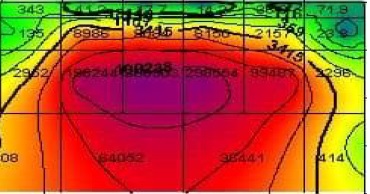Pre-Foundation Investigation Using Electrical Resistivity Method
A Case Study of Proposed Phase II, Faculty of Law Building, Federal University Oye-Ekiti, Nigeria
DOI:
https://doi.org/10.62050/ljsir2024.v2n2.321Keywords:
Engineering geophysics, VES, 2-D ERI, Geoelectric sectionAbstract
The proposed Phase II, Faculty of Law Building, was investigated to determine the competence of the sub-soil for building construction. The Electrical Resistivity method was employed for the geophysical investigation. The 2-D Electrical Resistivity Imaging (ERI) and Vertical Electrical Sounding (VES) techniques were adopted using the dipole-dipole electrode and Schlumberger arrays respectively. Using an electrode spacing (a) of 5 m and expansion factor (n) varying from 1 – 5, electrical resistivity measurements were taken along two traverses having South – North (SN) and East – West (EW) orientations respectively. Thirteen VES stations were occupied within the study area with half-current electrode spacing (AB/2) ranging from 1 – 65 m. The interpretation of the geophysical data was carried out using DIPRO software. The 2D ERI showed that the sub-soil along traverse 1 and northern part of traverse 2 has high resistivity values (>900 Ωm) at 4.5 m depth. The geoelctric sections identified three geologic layers comprising topsoil, weathered layer and fresh basement. The electrical resistivity results revealed that the sub-soils on or within the proposed site are found to be fairly competent for engineering structure.
Downloads
References
Olorunfemi, M.O., Ojo, J.S., Sonuga, F.A., Ajayi, J.O. & Oladapo, M.I. (2000). Geophysical Investigation of Karkaku Earth Dam Embankment. Global Journal of Pure and Applied Science, 6(1), 117 – 124.
Imposa, S., Cuomo, M., Contrafatto, L., Mineo, S., Grassi, S., Li Rosi, D., Barbano, M.S., Morreale, G., Galasso, M., & Pappalardo, G. (2023). Engineering Geological and Geophysical Studies Supporting Finite Element Analysis of Historical Buildings after Dynamic Identification. Geosciences, 13, 84. https://doi.org/10.3390/geosciences13030084
Greg H. (2021). The special demands on airborne geophysics of engineering projects. IOP Conf. Ser.: Earth Environ. Sci. 660 012120 https://doi.org/10.1088/1755-1315/660/1/012120
Augie, A. I., Saleh, M., & Gado, A. A. (2020). Geophysical Investigation of Abnormal Seepages in Goronyo Dam Sokoto North Western Nigeria Using Self-Potential Method. International Journal of Geotechnical and Geological Engineering, 14(3), 103 – 107
Glazunov, V. V., Burlutsky S. B., Shuvalova, R. A., Zhdanov, S. V. (2022). Improving the reliability of 3D modelling of a landslide slope based on engineering geophysics data. Journal of Mining Institute, 257, 771-782. https://doi.org/10.31897/PMI.2022.86
Ologe, O., Augie, A. I. (2020). Geophysical Investigation for Pre-Engineering Construction Works in Part of Ilorin, Northcentral Nigeria. International Journal of Geological and Environmental Engineering, 14(11), 341 – 347.
Eluwole, A.B., Bawallah., M. A, & Babatunde, O. (2015). Subsurface Integrity Assessment. International Journal of Advancement in Engineering Technology, Management and Applied Science, 2(2), 1 – 13.
Yahaya, M. N., Augie, A. I. & Samaila, B. (2020). Geophysical Investigation of Subsurface Formation for Construction Purposes at Southern Part of Gulumbe District, Kebbi State. Savanna Journal of Basic and Applied Sciences, 2(2), 153 – 159.
Akintorinwa, O. J. (2017). Application of Engineering Geophysics in Site Investigation: A Case Study of Ondo State University of Science and Technology, Okitipupa, Southwest, Nigeria. Journal of Sustainable Technology, 8(2), 12 – 23.
Rahaman, M. A. (1988). Recent advances in the study of the Basement Complex of Nigeria. Precambrian Geology of Nigeria
Rahaman, M. A., & Ocan, O. (1978). On Relationships in the Precambrian magmatic gneiss in Nigeria. Journal of Mining and Geology, 15, 23 – 33.
Ayoade, J. O. (1988). Introduction of Climatology for the Tropics. Abiprint and Park Limited, Ibadan
Idowu, A. A., Ayoola, S. O., Opele, A. I., & Ikenweiwe, N. B. (2011). Impact of Climate Change in Nigeria. Iranian Journal of Energy & Environment, 2 (2), 145 – 152.
Ademilua, O. L. (1997). A Geoelectric and Geologic Evaluation of Groundwater potential of Ekiti and Ondo States, Southwestern, Nigeria. Unpublished M.Sc.Thesis, Dept. of Geology, Obafemi Awolowo University, Ile-Ife, Nigeria, 1- 67.
Bayowa, G. O., Olorunfemi, M. O., & Ademilua, O. L. (2014). A Geoelectric Assessment and Classification of the aquifer systems in a Typical Basement Complex Terrain: Case study of Ekiti State, Southwestsern Nigeria. Research Journal in Engineering and Applied Sciences, 3(1), 55 – 60.
Mailu, G. M. 1987. Hydrogeology of the Metamorphic Region of the Athi Drainage Area. Kenya. Proceedings of the basement aquifer workshops, 15 – 24 June, 1987, Zimbabwe. Commonwealth Science Council, CSC (89) WMR – 13, TP, 273.
Shemang, E.M. 1990. Electrical Depth Soundings at selected well sites within the Kubani River basin, Zaria, Nigeria. Unpublished M.Sc. Thesis, A.B.U. Zaria, 108.
Lewis, M. A. 1987. The analysis of Borehole yields from Basement Aquifers. Proceedings of the Basement Aquifer Workshop, 15 – 24 June, 1987, Zimbabwe, Commonwealth Science Council CSC (89) WMR – 13, TP 273.
Abiye, O. D., Oni, A. G., Olorunfemi, M. O. (2019). Integrated Geophysical Investigation of Suspected Structurally Controlled Valleys within the Basement Complex Underlain Federal University Oye-Ekiti, Southwestern Nigeria. The Pacific Journal of Science and Technology, 20(2), 319 – 331.

Downloads
Published
Issue
Section
License
Copyright (c) 2024 Lafia Journal of Scientific and Industrial Research

This work is licensed under a Creative Commons Attribution-NonCommercial-ShareAlike 4.0 International License.









